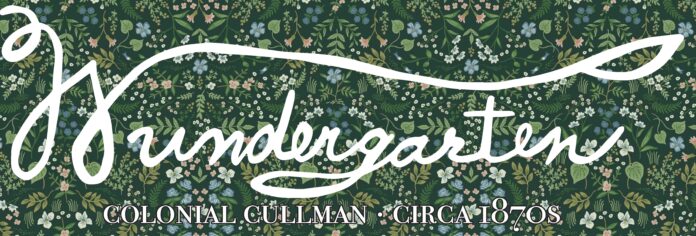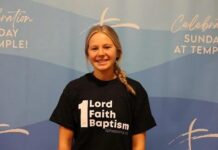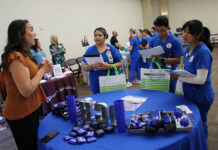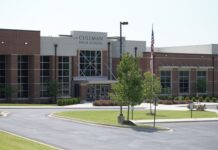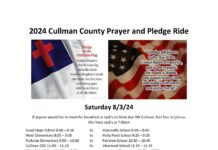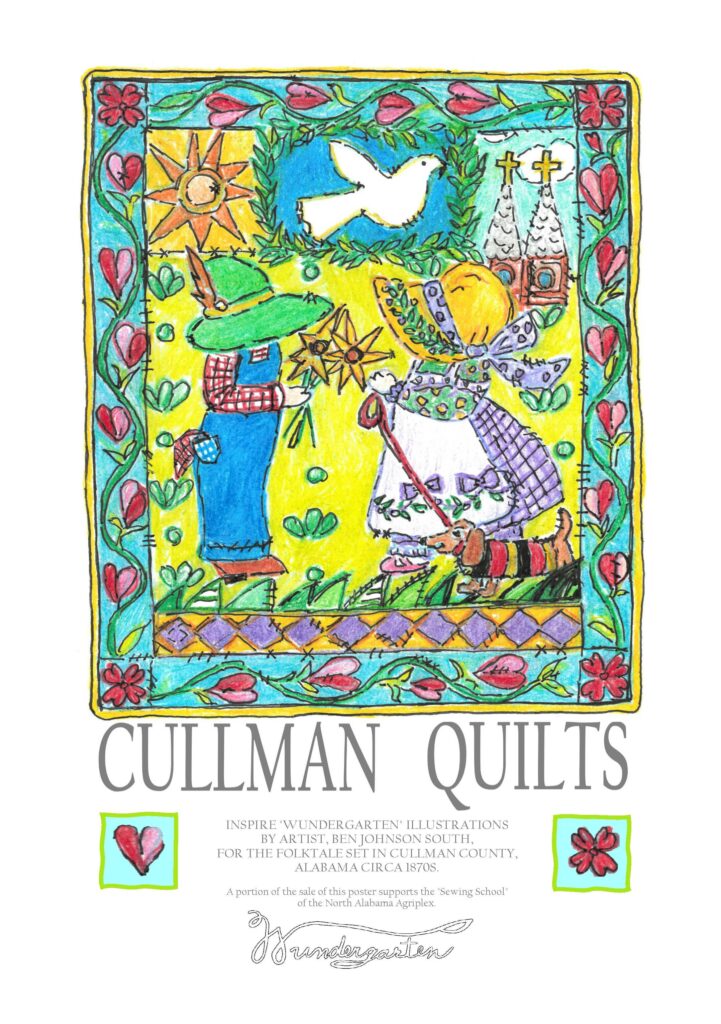
CULLMAN QUILTS inspired the art style I used to illustrate the folktale, “WUNDERGARTEN” (see the Cullman Quilts poster, available at Leldon’s in the Warehouse District). My very earliest memory is being a 3-year-old playing under a quilt frame in the Cullman County community of Grandview. A group of warm, welcoming ladies invited my young mom to join them catching up on the local news and stitching a colorful quilt top.
This was in the 1950s, but the heritage sewing techniques were the same ones used by the heroine of “WUNDERGARTEN,” Frau Ruehl, in the 1870s. During the early days of Cullman County, quilts with “foundation piecing” were popular.
Frau Ruehl would have cut paper into shapes and used that template as a pattern for her quilts. Each individual piece of cut fabric was basted around the paper shapes.
Paper was scarce in Colonial Cullman, that period between 1870 and 1895, so Frau Ruehl saved letters she received from her relatives in Germany, postcards and newspaper and train station posters to use as her quilt patterns.
The cabin at Frau Ruehl’s strawberry farm and the garden shed where our young hero, Fritz, slept had warm, multi-layered quilts for winter. During spring and autumn months, they had quilts with no inner batting that they slept under to ward off a chill in the cool, cool, cool of the evenings.
CULLMAN QUILTS have stitched together the community from the beginning of the county’s history. Last Sunday, Tammy White and Frances Cooper of the Cullman Historical Society welcomed me to share the early readers’, seven-minute version of the “WUNDERGARTEN” folktale and give some insider details about the local inspirations for the story set in Cullman County, circa 1870s.
Eighty people gathered at the Cullman County Museum to share our Cullman-centric memories. Mehayley Peinhardt Laney loaned us two “Sunbonnet Sue” quilts her grandmother Nell Norris created. There was an audible chorus of “oohs and aahs” as the packed room saw how the traditional quilt patterns and beautiful needlecraft of Norris, now deceased, had informed the 2023 illustrations for “WUNDERGARTEN.” (Side note: A gifted seamstress, Norris was the very first artisan hired by Jerry Wootten when he founded the now thriving textile company HomTex.)
Joining us at the Cullman County Museum was Hazel Ruehl (Bill), who is acknowledged as one of the most accomplished quilters in present-day Cullman County. It was an honor to have Hazel and Bill Ruehl at the free, open-to-the-public event. They said relatives around the county and even some as far as Texas had asked how the fictional Frau Ruehl (pronounced “real”) became the heroine of “WUNDERGARTEN.”
Someone in the audience at the museum asked Hazel Ruehl if some Cullman quilters like her might take one or some of the 12 illustrations from “WUNDERGARTEN” and transform them into “real, or Ruehl” quilts. Not missing a bit and with characteristic, “CAN-DO CULLMAN” positive attitude, Mrs. Ruehl said, “Sure, I can get with some others and make that happen.” I hope that does happen. Cullman quilters would bring their own artistry and skill to the many other creatives working together on all the diverse, “WUNDERGARTEN” crafts.
Bill Ruehl shared some photos of the Cullman-based wagon factory his family created in our county. The long-ago advertisements for the wagons showed elegant, unpretentious wagons like those Frau Ruehl would have used to transport her cherished German strawberries to the Cullman train depot to ship them for a profit to appreciative customers in far-flung places like Cincinnati and Montgomery.
The big, red-bricked building where the Ruehl wagons were hand-built is not only still standing, but also, in true, German and Cullman fashion, has been repurposed for another century of usefulness. It is an extension of St. John’s Evangelical Protestant Church, where the county’s founder, Colonel Cullman, was a member. This could be a lovely hall to have a show of Cullman County-made quilts and perhaps some St. John’s member sharing the story and “quilt images” of the folktale.
CULLMAN QUILTS are not just quaint, antique, museum objets d’ art. Quilting in our county remains a popular craft and artistic expression. My friends Sondra Waters Nassetta and Concetta Lavoy Kreps are just two of many residents in the area who keep quilting popular and contemporary. In fact, just a few months ago, Kreps won the first-place ribbon in the 31st annual quilt show held by the Decatur Public Library in Morgan County.
In this storytelling culinary series, “Celebrating in the Wundergarten,” we are imagining German dishes from the recipe box of Fraulein Ruehl, the heroine of the folktale “Wundergarten.”
In 2023, both the City of Cullman and The Cullman Tribune, Alabama’s oldest continuously published weekly newspaper and Cullman County’s oldest business, are celebrating their 150th birthdays.
But, for 21st century cooks, our celebratory recipes embrace modern ease and have a greater array of ingredients than Frau Ruehl would have had in her pantry.
CULLMAN QUILTS inspire this fun and healthy recipe. We reached back into The Cullman Tribune’s archives to share a creation that was part of the award-winning series, “The 67-County Alabama Garden Party.” Yours truly, Ben Johnson South, with recipes engineered by my talented sister-in-law, Laurie Johnson, brought home the 2019 “Best Feature Series” for The Cullman Tribune, awarded by the Alabama Press Association.

Quilted pan-roasted vegetables (Laurie Johnson)
WUNDERGARTEN QUILTED PAN-ROASTED VEGETABLES
(Source: Laurie Johnson)
Ingredients
- Fresh, colorful vegetables, chosen by the colors in your favorite quilt, such as: carrot sticks, multi-colored bell peppers (green, red, yellow and orange), red onions, green onions, yellow squash, zucchini, purple small potatoes, cauliflower, asparagus spears, green beans and cherry tomatoes
- Cooking spray and/or olive oil
- Salt and black pepper
- Optional – minced fresh herbs such as parsley, thyme, basil, oregano, etc.
Instructions
- Preheat oven to 425 F.
- Prep vegetables – Slice carrots, multi-colored peppers, onions, squash and zucchini into thin strips. Cut potatoes in half or quarters depending on size, cut cauliflower into small florets and snap off the tough ends of the asparagus. Leave the green beans and cherry tomatoes whole. If any of the veggies are wet, blot them with a paper towel as moisture is an enemy to roasting.
- Make your quilt – Spray a non-stick sheet pan lightly with cooking spray. Arrange the vegetables, by colors, into the pattern of the quilt, blanketing the whole pan. Brush tops lightly with olive oil (or spray with cooking spray) and season with salt and black pepper. You will likely have raw vegetables left, so have fun creating your own quilt art with a second pan!
- Roast for about 25-30 minutes or until vegetables are softening, maybe even browning a little, and tomatoes are just starting to pop open. Sprinkle with (optional) herbs and rotate the pans in the oven halfway through.
- Let cool a bit and transfer to table still warm.
HAPPY FIRST WEEK OF MARCH and AUF WIEDERSEHEN Y’ALL!
Find all columns in this series at www.cullmantribune.com/tag/celebrating-in-the-wundergarten.

